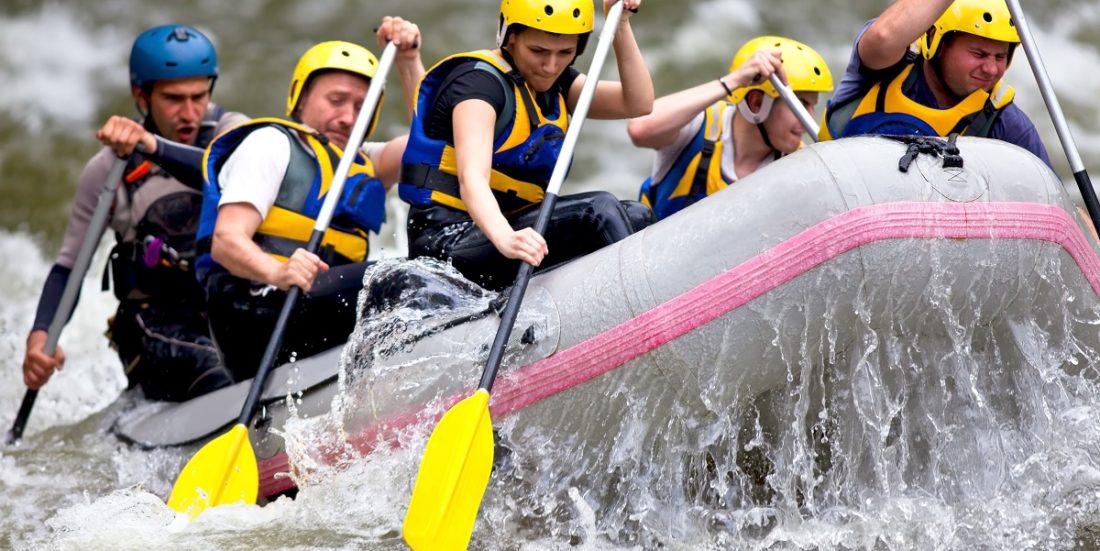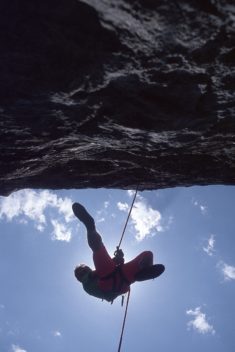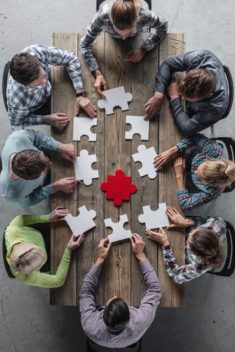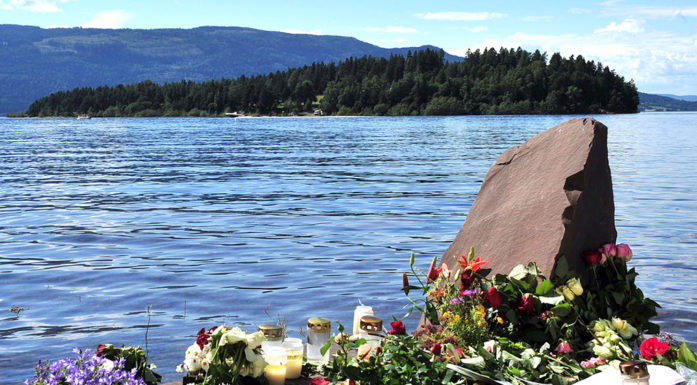Team building doesn’t really work
Rafting, paintball and go-karting on company outings do not improve interactions at work. Strangely enough, these activities can make things worse.
TEAM BUILDING: Your company has had a challenging period with major organizational changes. Employees have been assigned new tasks, and several have had to change jobs. The boss decides to put team building on the schedule, and invites all employees on a company outing.
The plan is for high adrenaline group activities aimed at enhancing employees’ communication and collaboration skills. The overall goal is to help people become better acquainted with each other and to improve teamwork
A few weeks later, “Janice” from the finance department rappels down a precipitous cliff to encouraging chants from her colleagues on the ground.
The boss is happy with the programme, and Janice might have overcome a fear. But does rappelling on a company outing lead employees to cooperate more when they return to the office?
Zero effect in the office
“It’s fine to have fun at work, but there’s no research showing that activities like these result in improved workplace interaction afterwards – even though corporate team building companies may claim otherwise,” says Kenneth Stålsett at NTNU’s Department of Industrial Economics and Technology Management.
Stålsett wrote his doctoral thesis on team development. He believes that relevant exercises are key for team development to be effective, along with surroundings that are similar to employees’ everyday working conditions. Paintball and rafting may constitute effective team training if you’re a soldier or a stuntman – but not if you’re an engineer or accountant and work in an office.
In that case, this kind of activity might just strengthen already established ties between colleagues, rather than develop new ones – and at worst could create unfortunate situations that then infiltrate the workday. Nor does it help the situation if alcohol is involved.
Activities that exclude
“Let’s say that a business with 30 employees goes on a company retreat to work on team development. As a rule, people spend most of their time with only a few of their colleagues – generally the ones they already know from before,” says Stålsett.
He also notes that activities that differ greatly from the way employees work on a daily basis are usually not for everyone. Engineers might find learning to collaborate to be a nightmare if it requires them to lie on the floor in a large room and touch each other.
As might the middle aged woman with a fear of heights who usually works in an office, but finds herself standing terrified on top of a cliff and thinking that there is no way she’ll be able to rappel down to her colleagues on the ground. They try to encourage her by telling her this is fun, and to do it for the team – but that doesn’t help. Suddenly she is no longer part of the community, and she goes from being an asset to the company to being shut out. She ends up changing jobs.
Team building for sale
These are two real occurrences – among numerous others – that Stålsett has come across through his research, data collection and working with operational leadership.
“Some commercial outfits that market team building activities argue that team building is important and that it can happen by rafting and rappelling. A boss who hires one of these adventure companies for a hefty sum can then cross team building off his to-do list. But these activities won’t improve employees’ collaborative abilities at work,” says Stålsett.
He stressed that team development certainly does not need to involve physically demanding activities, but it can be challenging emotionally. Team development is partly about breaking down entrenched behaviour patterns and establishing a common behavioural approach.
“Employees who are normally the most visible may need to tamp down their strong presence, whereas those who tend to be more reserved need to step into the limelight. Perhaps the person who is always kind and decent needs to become more authoritarian, while the one who never speaks up needs to give voice to his or her criticism,” Stålsett says.
We react to changed behaviour
However, this is incredibly difficult, since we harbour expectations of others’ behaviour in our social interactions. When an individual’s behaviour deviates from the norm, it tends to be rebuffed, ignored or met with scepticism.
Stålsett gives an example: “Imagine that someone who is always stern and authoritarian, suddenly does a 180 and is very nice. Wouldn’t most people assume that this person has a hidden agenda?”
The same applies to a jovial and pleasant guy who tries to be stern.
“People would probably think that he was trying to be tough, or that he got up on the wrong side of the bed. This indicates that people have to work on these skills together, as a team,” says Stålsett.
Developing a range of behaviours
As part of his doctoral project, Stålsett followed the Norwegian Naval Academy on an 11-week exercise in team building and team development under demanding conditions on board the sailing ship Statsraad Lehmkuhl. Data was collected from four different teams, where each team consisted of eight people.
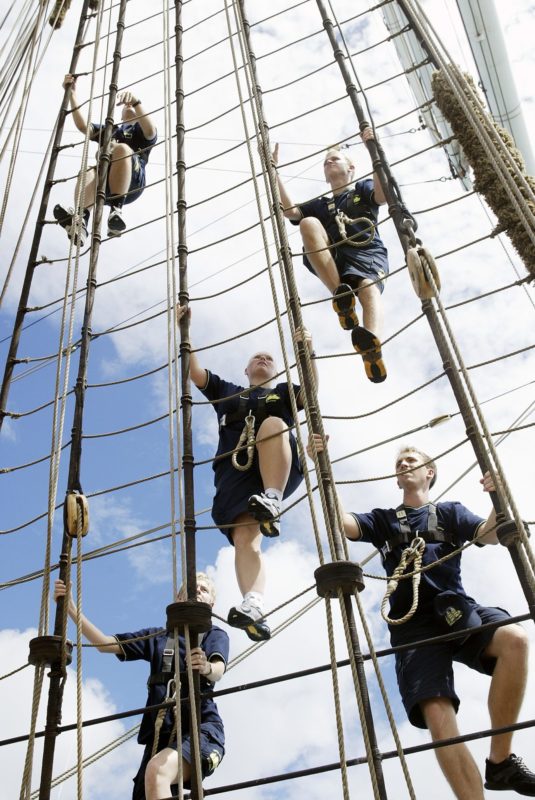
Cadets from the Norwegian Naval Academy during a previous expedition on Statsraad Lehmkuhl. These cadets were not among the ones that Kenneth Stålsett studied. Photo: Torgeir Haugaard, Norwegian Armed Forces
The instructors at the Naval Academy gave direct feedback to the teams along the way, so that both the individual members and the teams could change and evolve.
Team members who were very active might, for example, be told to make more room for others, while less active members were asked to take more space. The teams also discussed each other’s behaviour and roles during the exercise.
Three of the teams improved their ability to collaborate over the exercise period, even though they also had challenges they failed to solve. These teams worked the hardest to understand each other’s behaviour, attitudes and influence in the group, and members encouraged each other more to assume new roles and functions.
Members of the fourth team, who did not manage to improve their interactive skills, were concerned most with the specific tasks they had to solve.
First impressions are lasting
Stålsett also looked at the groups’ perceptions of each other, and how they affected effective collaboration. He followed Naval Academy cadets throughout a whole year, and made three different assessments.
The results show that our first impressions of another’s behaviour and attitudes remain surprisingly intact, and that it is difficult to break down and change the initial stereotypical assumptions we make about each other.
“If you’re perceived as authoritarian in the beginning, people don’t always see when you moderate that behaviour. Group development takes time, effort and determination,” says Stålsett.
Through the study he found that the cadets at the Naval Academy had good technical training on weapons systems and other tasks they work at a lot. The interpersonal interactions were much more difficult to work with, even over a whole year, and it became clear that interpersonal development does not happen overnight.
Stålsett therefore emphasizes the advantage of long-term teams that maintain the same group makeup as long as possible.
Electronic sensors tracked group dynamics
Stålsett’s doctorate is part of the NTNU research project Innovative Teams, which addresses the management of teams that are under severe pressure and that have to interact and adapt as a situation changes.
As part of this project, sensor tags were developed that track whom members in a group are talking to, how they react to what is being said and done, how they talk, plus body movements.
Stålsett observed the interactions of two teams at the Naval Academy, and compared his observations with information from the sensors that each group member wore. The data says something about how influence affects group dynamics and how influence is distributed among group members.
Hard to change
The results confirm that it is difficult to change influence in groups – despite the fact that instructors provided study participants with ongoing feedback on their behaviour.
“We observed that the teams that are well developed usually also have relatively shared influence – and that it is situational. At the same time we saw that it’s tough to get the person with greatest influence to pull back once this pattern has established itself in the group,” says Stålsett.
His dissertation illustrates how team building should be tailored to the unique challenges that exist within each group, and that team building should be a recurring exercise.
In other words, team building isn’t anything that can be carried out on a go-kart track during a company outing.
